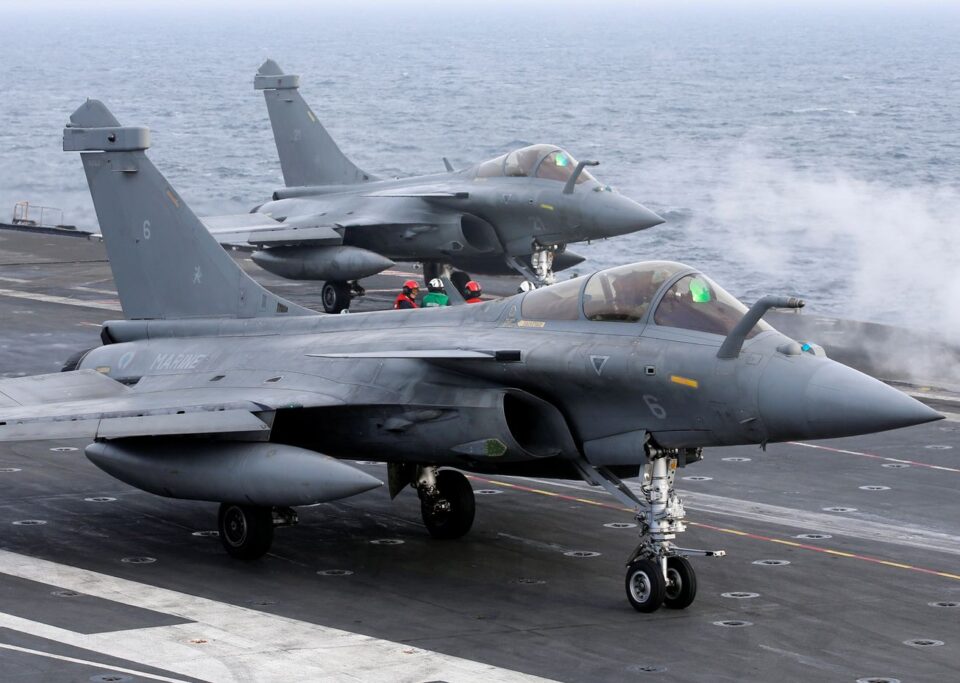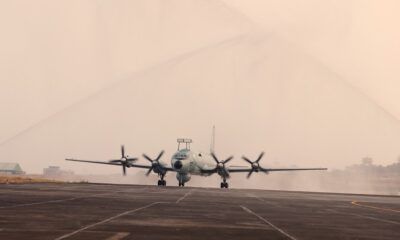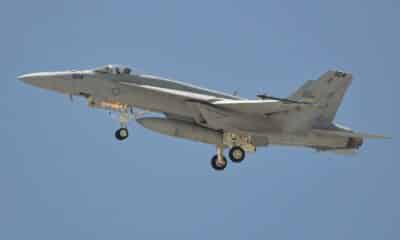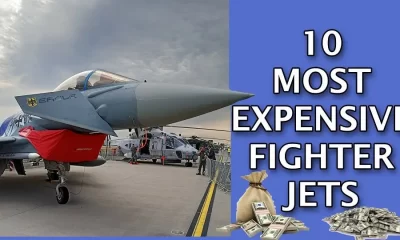Aerospace
Indian Navy to buy Rafale M fighter plane after IAF?

The internal news that India would purchase more Rafale Jets for the Indian Navy as part of a fresh batch of upgraded fighter jets for Indian defence is being released by the French media. According to the source, the two nations can sign this agreement when French President Emmanuel Macron travels to India in March.
As part of an ongoing deal for fighter jets for the aircraft carrier of the Indian Navy, two fighter jets from different countries are involved: one is the French-built Dassault Rafale and the other is an American F/A18 Super Hornet. A few months ago, the two fighter jets demonstrated their ability to conduct operations over the Indian aircraft carrier. The race to acquire this contract could be a significant development for the Indian Navy’s future aircraft supplies.
A total of 36 fighter planes built by Rafale have already entered service with the Indian Air Force. France is now looking for the fighter jet requirements from the Indian Navy. As stated, it will offer all necessary assistance for Indian defence, and it is also constructing component production in India with local suppliers.
It is French media claimed that India turned down the American Jet F/A 18 super hornet and opted instead for the Rafale agreement. This agreement will mark a significant turning point in Indian-French ties. Additionally, according to the media source, the Indian Navy is ready to agree to a multi-billion dollar purchase agreement with France for 26 Rafale M aircraft.
10 Most Expensive Fighter Jets In The World(Opens in a new browser tab)
The opposite The American company Boeing has previously stated that the F/A Super Hornet was specifically designed for naval carriers, has a wide range of features, connects to Boeing P8 maritime aircraft for surveillance support, and has the newest aircraft, all of which have improved India’s ability to fight off enemies.
Europe’s Future Combat Air System: on the way to the first flight(Opens in a new browser tab)
43 obsolete Russian MiG-29K and MiG-29KUB fighter planes are now in the Indian Navy’s fleet. The Navy had numerous potential names for the aircraft, but the Rafale M and the F-18 ultimately won the race. 240 Rafale M planes are now in the French Navy. These jets have been produced by Dassault since 1986.
The Indian New Aircraft Carrier is equipped with the newest defence weaponry, as well as—and this is crucial—aircraft accommodation on its deck that is appropriate for the Rafale and Super Hornet.
Here’s Why A Toilet Is Hanging On A Navy F/A-18 Super Hornet’s Wing(Opens in a new browser tab)
In addition to France and India, Egypt, Qatar, and Greece all fly state-of-the-art French fighter jets. The UAE and Indonesia also agreed to buy 80 Rafales in December 2021 and 42 Rafales in February 2022, respectively.
According to certain sources, the Rafale jets might be very significant to the Indian armed forces. In technical terms, Rafale will be simple to maintain as it is already in use by the Indian Defense. Another major issue with this purchase is the two-seater Rafale, which Dassault does not supply even though it could be appropriate for the Indian aircraft carrier. but in addition, it will equip this fighter with the MBDA and other armaments.
With the purchase of the Boeing military, Chinook, P8, and Apache aircraft, India and the US have already established defence connections. Even if they lose their contract, Boeing won’t be significantly impacted. But according to French media, there is no proof to far that India is indeed interested in purchasing Rafale fighters for its Indian Navy.
Source: First Post

Aerospace
Which is bigger 777x or 787 aircraft ?

The 777X is a new series of the Boeing 777 family and is designed to be larger and more efficient than its predecessor. It features two variants: the 777-8 and the 777-9, being the larger of the two.
The Boeing 777X emerges as the larger sibling within the Boeing family, representing a significant leap forward in both size and efficiency. Comprising two variants, the 777-8 and the 777-9, the latter takes the crown as the larger of the two. With its expansive fuselage and impressive wingspan, the 777X is tailored for long-range journeys and boasts a substantial passenger capacity.
On the other hand, the Boeing 787, affectionately known as the Dreamliner, occupies a niche in the market as a smaller yet formidable aircraft designed for medium to long-range flights. Its distinguishing feature lies in its composite fuselage, a technological marvel that renders it lighter and more fuel-efficient compared to conventional aluminum counterparts. The Boeing 777X is larger than the Boeing 787 aircraft.
When it comes to passenger capacity, the 777-9 reigns supreme, typically accommodating a sizeable contingent of 400-425 passengers in its standard configuration. In contrast, the 787, with its more modest dimensions, typically carries between 240-290 passengers, depending on the variant and layout.
One of the remarkable innovations introduced with the 777X is its folding wingtips, a feature designed to address the logistical challenges of accommodating such a large aircraft in conventional airport gates. These folding wingtips enable the 777X to retract its wings, allowing it to fit into gates designed for smaller aircraft while still reaping the benefits of an extended wingspan during flight, thereby enhancing fuel efficiency and operational flexibility
Aerospace
China Secures Production Certificate for Mass Production of Pilotless eVTOL Aircraft

The first passenger-carrying pilotless electric vertical takeoff and landing (eVTOL) aircraft in the world, the EH216-S, has received the Production Certificate for its eVTOL aircraft from the Civil Aviation Administration of China (CAAC).
This is a significant milestone for EHang Holdings Limited, the leading UAM technology platform company in the world. This outstanding accomplishment is another big step towards mass manufacturing for the eVTOL aircraft and the ensuing commercial operations, building on the ground-breaking acquisition of the Type Certificate and the Standard Airworthiness Certificate for the EH216-S.
The PC is a crucial certificate that the aircraft maker receives from the CAAC, the country’s aviation authority. By obtaining this certificate, EHang has demonstrated that it has set up a quality management system for mass production that satisfies the airworthiness regulation standards set forth by the CAAC, and the company has been given permission to continue producing mass quantities.
It is also a strong guarantee of the calibre of the goods made by EHang. Raw materials, supplier management, manufacturing organisation, production quality control, aircraft pre-delivery test, after-sales repair and maintenance, etc. are all included in the mass production quality management system for the EH216-S.
To ensure that every aircraft and its components that roll off the production line strictly adhere to the approved type design and safety requirements, the system sets clear guidelines and documentation for every step in the production procedure. This ensures comprehensive traceability and safety control.
Aerospace
Four Airbus A380 Superjumbos lined up to be scrapped

In a strategic move aimed at reclaiming valuable resources from the iconic Airbus A380 aircraft, VAS Aero Services and Dr. Peters Group have announced a significant collaboration.
This partnership marks a milestone in aviation logistics and aftermarket services, with four of these colossal planes slated for teardown and redistribution of used serviceable material (USM).
The venture between VAS Aero Services, renowned for its expertise in aircraft dismantlement, and Dr. Peters Group, a prominent Germany-based investment fund management firm, underscores a commitment to sustainable aviation practices. This isn’t their first foray into scrapping A380s; their successful partnership has already seen the dismantlement of these aircraft, making them pioneers in this niche.
Under the agreement, the latest consignment brings the tally to eight A380s entrusted to VAS by Dr. Peters Group. Managing Director Christian Mailly of Dr. Peters Group emphasized the trust placed in VAS, citing their unparalleled capabilities in dismantlement and aftermarket sales network. It’s a strategic move in response to the growing demand for quality USM parts, particularly with the resurgence in reliance on the A380.
Notably, the teardown process will be carried out at various locations, optimizing the positioning of harvested parts to cater to different markets. While some parts will be positioned in Europe to support operators in the region and the Middle East, others will remain in the Asia-Pacific region. This meticulous strategy ensures efficient access to spare parts, benefiting MROs and airlines across these markets.
The decision to retire these A380s comes at a time when operators are reassessing fleet strategies amidst evolving market dynamics. Despite initial plans for quick retirement due to the emergence of more fuel-efficient alternatives, factors such as a rebound in long-haul demand and delays in new widebody deliveries have prompted operators to reconsider. The A380, with its unique capacity and capabilities, presents a practical solution for short-term capacity management.


























